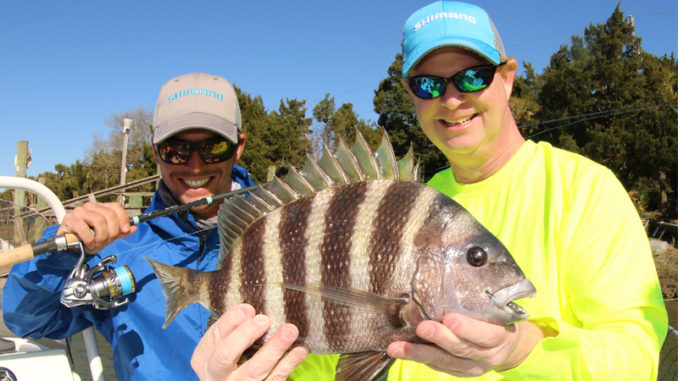
Strangely-named fish is fun to catch, tasty to eat
Sheepshead (Archosargus probatocephalus) are strangely-named fish. And they have teeth that look strangely out-of-place. The teeth are much larger and more mammal-like than those of most other fish.
Nevertheless, many anglers seek this fish for their sporty fight as well as their tasty table fare. They are difficult to catch, and most successful sheepshead anglers devote a lot of time to specifically targeting them, rather than just fishing for whatever is biting.
These fish are somewhat oval shaped, much like a freshwater bluegill, but sheepshead grow much larger and are more elusive. They have a silverish-green to gray body with five or six dark vertical bars that run all the way from the dorsal fins to the bottom of the fish’s body. They have a well-defined lateral line that runs horizontally from the rear of the gill plate down the center of the body toward the tail.
A sheepshead’s dorsal fin has 12 spines and 11 soft rays. The spines are very sharp and should be avoided by anglers. They have slightly forked tails. Inside their mouths are four wide teeth that resemble incisors on both sides of the jaw. They also have numerous molar-like teeth depending on the fish’s age and health.
Their teeth aren’t just for looks!
These fish use their teeth to crush and grind invertebrates that commonly live around concrete, metal, and wooden structures. Their diet is made up of mussels, clams, oysters, barnacles, crabs, shrimp, and occasionally small fish. They consume a good deal of algae as well, but fisheries biologists aren’t sure if that is by choice, or if they just happen to eat the material while foraging for their favorite foods.
Observant anglers often spot these fish swimming up and down pier pilings, bridge supports, and other sunken debris. They are looking for, and eating, whatever they can find among the barnacles.
Some sheepshead stay inshore year-round, and many move between offshore, nearshore, and inshore structures, usually in the fall and early spring. Anglers catch them throughout the year on sunken trees, bridge and pier pilings, rock jetties, reefs, wrecks, and live bottom. Some anglers report catching them in shallow open water around oyster mounds.
Fiddler crabs serve as one of the top baits for sheepshead anglers. Mussels, clams, and shrimp are also good bets. A small number of anglers fish for sheepshead with artificial lures like Cranka Crabs, Coco the Crab, Savage Gear’s 3D Crab, and Berkeley Gulp! crab lures.
Most anglers target sheepshead with vertical presentations
Rather than casting and reeling in, sheepshead anglers typically fish directly below their position. The fish has a very quick bite which is difficult to detect. Many beginning sheepshead anglers hear the term “set the hook before the fish bites” when talking to more experienced sheepshead specialists.
Sheepshead are often confused with spadefish and black drum. They are most commonly misidentified as black drum, which also have dark vertical bars and are often caught in close proximity to known sheepshead hotspots.
Some nicknames for sheepshead include convict, convict fish, bait thief, toothy bream, sheep bream, sea bream, and saltwater bream.
Chris Robbins caught the North Carolina state record sheepshead in 1999 out of Oregon Inlet. The fish tipped the scales at 19-pounds, 4-ounces.
South Carolina’s state record sheepshead weighed 16-pounds, 6-ounces. Jimmy Widener of Hanahan caught the fish out of Charleston in 2008.
The world record sheepshead has stood since 1982 when Wayne J. Desselle caught the 21.25-pound fish out of New Orleans, La.
The fish’s name is interesting for more than just it’s uniqueness. It can be pronounced and spelled as either sheepshead or sheephead. Both are acceptable according to American English dictionaries and fisheries manuals.
Click here for a video about catching sheepshead.



